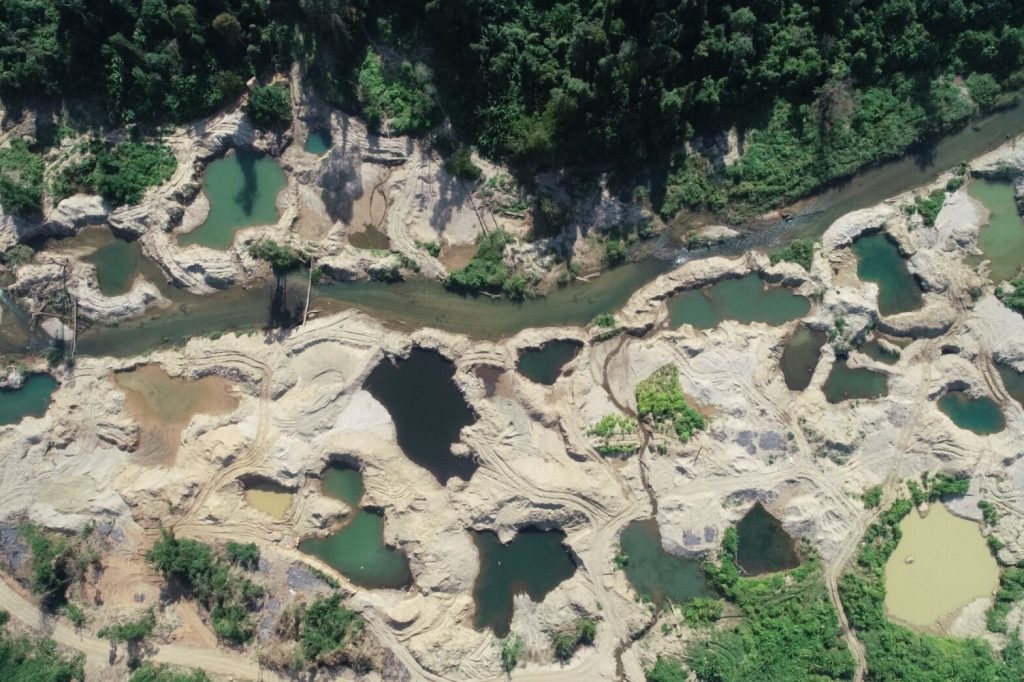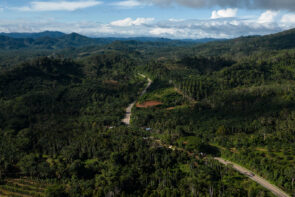One of the most successful conservation projects in the country now under threat from unregulated extractive industry.
DAWEI, MYANMAR – Unregulated and irresponsible gold mining has surged within Myanmar’s southern nature reserve area, putting nearly two decades of conservation efforts under threat.
Zimbar Creek and the surrounding lush forest inside the Tanintharyi Nature Reserve (TNR) – one of the country’s most successful nature reserve projects – in Dawei district in Myanmar’s southern Tanintharyi region have recently been turned into a moon-like landscape.
Villagers living near the conservation areas witnessed the arrival of big machinery that was used to dig up the bed of the creek in search of gold – in an area that was once a safe haven asset in the war-torn country now crushed by high inflation.
Large and small pits are now spread for almost 25 kilometers along the creek, some even further inland, and destroying the forests.
“The ecosystem of the forests has been degraded,” said a villager who asked not to be named due to security concerns.
“People from our village depend on the water from the creek. Now it has been murky and polluted by the mining. We can’t use or drink it anymore.”
Gold mining has surged and has been devastating the TNR since the 2021 military coup that threw the country into turmoil and weakened environmental law enforcement.
The lack of enforcement of environmental standards has driven the extractive industries into conservation areas nationwide.

Established in 2005 in Yebyu and Dawei townships, the TNR covers the 170,000-hectare tropical rainforest and grasslands that provide habitats to endangered species like Asian elephants and leopards.
This $US6 million nature reserve project was funded by Thai and Myanmar gas companies – Moattama Gas Transportation Company Limited, Tanintharyi Pipeline Company and PTTEP’s Andaman Transportation Limited – that run pipelines across the area to transport gas from Myanmar to Thailand.
The aim of the reserve was to compensate for the impacts on biodiversity caused by the pipelines and gas facilities, which overlap the largest remaining areas of low and mid-elevation seasonal evergreen forest in Southeast Asia.
A 2020 investigation by Dawei Watch, a local news agency covering the Tanintharyi region, found four major gold mining sites covering more than 70 hectares along Zimbar Creek – a main tributary of the Dawei River.
These mining sites were allegedly run by officials from the Karen National Union (KNU), which controls the TNR territory, and the Myanmar military, which set up bases there. The KNU is Myanmar’s oldest resistance force and controls some parts of eastern and southern Myanmar.
The exposure of illegal activities led to a government inspection and mining closure in the same year. However, gold mining resumed after the coup, and even more devastated the nature reserve.
Mining expanded
Using satellite images, Dawei Watch’s recent investigation found that the gold mining area along Zimbar Creek had increased 10 times – up to 703 hectares – from a pre-coup year to January this year. Water channels in some sections of the creek have nearly disappeared.
The mining area even reached Nat-Eain-Htaung village, known as Pilok in Thai, near the Myanmar-Thai border where tin and tungsten were mined four decades ago.

There is an existing two-lane road near the creek heading directly to the border area. This road was built for workers to access and maintain the pipelines that transport natural gas from Myanmar’s offshore area to Thailand.
But the road has been turned into a pathway for miners to transport their equipment and machinery.
“It is impossible for villagers to come close to the gold mining area without having any contact with the military or the armed group,” said a Zimbar villager who asked to remain anonymous.
Individual gold miners said they must pay fees to the armed group, depending on the size of their excavation area and the amount of extracted gold ore. In some cases, the fee for individual gold miners is about 10,000 Kyat ($US5) a month, plus one-tenth of the gold ore’s value.
For those running a big mining site, the monthly fee can reach two to five million Kyats ($950 to $2,380).
“Both large- and small-scale miners need to obtain certificates from the KNU official at Mi-Chaung Hlaung village west of the TNR territory,” said a villager from Yebyu Township. Workers in the mines mainly come from upper Myanmar.
This is not the first report on the impacts of mining on local livelihoods in the Tanintharyi region, where the extractive industry thrived even before the coup.
In 2015, local villagers in Myaung Pyo protested against the Heinda tin mine operated by a Thai firm and one of Myanmar’s state-owned enterprises. They accused the mine of causing sedimentation and contamination in the water supply, which was denied by the mining operator.
Local news reported the same year that villagers in Ka Htaung Li village complained about water pollution in a stream caused by a gold mining operation. They alleged the military attempted to silence them.
However, the villagers and civil society groups were able to organize street protests and negotiate with the military and the armed group under the civilian government.
But the bloody crackdown on dissent since the 2021 coup has brought environmental movements – including protests against irresponsible mining – to a grinding halt.
Unrecognized conservation
Padoh Alnar, the secretary of the KNU brigade overseeing the eastern part of Tanintharyi in southern Myanmar, admitted there is mining in the TNR territory.
However, his armed group does not recognize the TNR as a conservation zone, meaning mining can go ahead under the KNU’s regulations.
This stance can be traced back to the pre-declaration period of the nature reserve, when the gas pipelines were laid down and forced Karen villagers to relocate in the 1990s.
It was reported that the military attacked the villagers during the forced evictions, making the establishment of the TNR a decade later illegitimate in the eyes of the KNU.
“During the ongoing war [as a result of the coup], there might be some delays in taking action [on irresponsible miners.] [The mining] might cause an impact on the quality of water. But there is no huge impact on the villagers so far. If the villagers have harmful effects, we will take this into account,” Padoh Alnar told Dawei Watch.
“We respect the rights of villagers. We will cooperate with them.”
He denied the KNU had collaborated with the military in the mining, as some villagers believe. The KNU does not collect tax from artisanal miners, he added. But if the miners use machines, they have to pay a tax to the KNU. He did not elaborate on the fee.

The TNR is an example of the challenges faced by conservation efforts in Myanmar, when the central government and an armed group do not always agree on a common goal or they aim to use land for different purposes.
These types of land conflicts have been seen during past civilian governments as ethnic armed groups took control of different parts of the country and installed their own governments and regulations.
However, they were still open for negotiations with the central government. The latest coup broke that coordination between the two.
Despite no consensus agreement with the KNU, in October 2018, Myanmar’s civilian government led by the National League for Democracy started pushing for the TNR to be recognized as an ASEAN Heritage Park – a designated protected area in Southeast Asia nations known for their unique biodiversity and ecosystems, and outstanding values in culture, research and tourism.
Officials then launched an operation to crack down on illegal mining and logging in the nature reserve. But the miners managed to stay one step ahead.
When officials arrived at mining sites, all they found were abandoned huts, some water pumps and unused fuel tanks.
On the other hand, local villagers affected by the mining submitted letters of complaint to the local government and relevant organizations, including the KNU. But they claimed no action was taken.
“Officials could not stop gold mining in the reserve, and they had given up,” admitted an official who oversees the TNR.
A villager from Zimbar said he and his community decided to stop complaining about the mining as it was too risky under the junta government.
This story was first published in Burmese by Dawei Watch, a local news agency covering the Tanintharyi region. Mekong Eye provided editorial support for the English version of the story.










